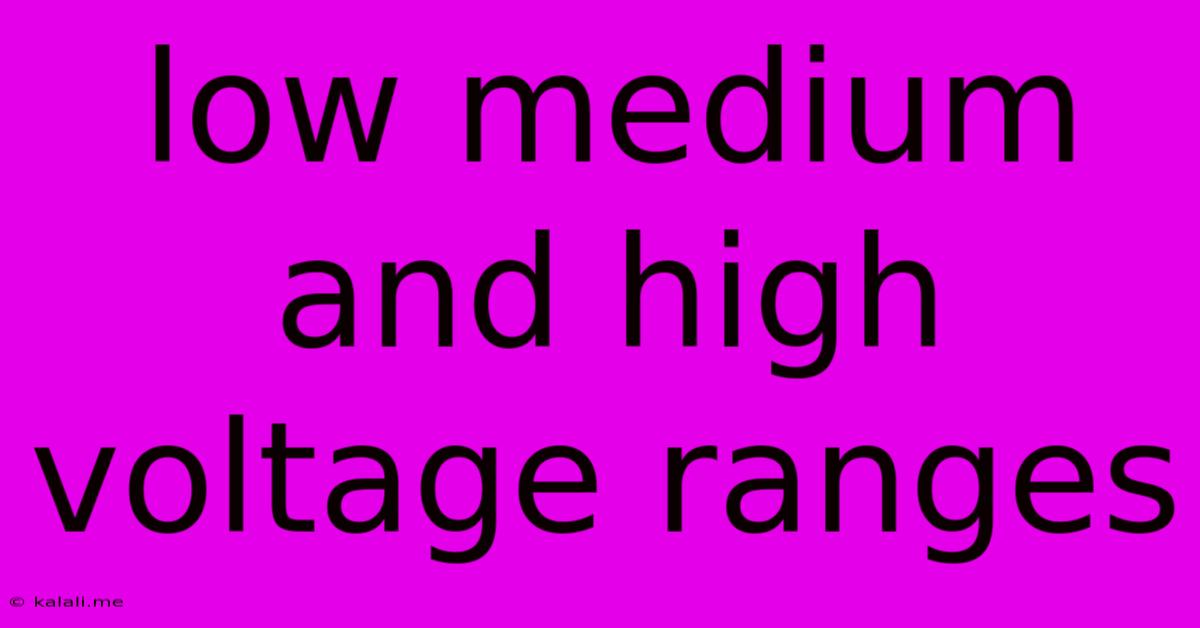Low Medium And High Voltage Ranges
Kalali
Jun 15, 2025 · 3 min read

Table of Contents
Understanding Low, Medium, and High Voltage Ranges: A Comprehensive Guide
Meta Description: This guide provides a clear understanding of low, medium, and high voltage ranges, their applications, safety precautions, and the key differences between them. Learn about voltage classifications and the importance of proper handling procedures.
Voltage is a fundamental concept in electricity, representing the electrical potential difference between two points. Understanding the different voltage ranges – low, medium, and high – is crucial for electrical safety, proper equipment selection, and efficient system design. This article will delve into the specifics of each range, exploring their typical applications, safety considerations, and the distinctions between them.
What Defines Low, Medium, and High Voltage?
The precise voltage boundaries defining low, medium, and high voltage can vary slightly depending on the region and specific standards (like IEC or IEEE). However, a generally accepted classification is as follows:
-
Low Voltage (LV): Typically ranges from 50V to 1000V AC or 120V to 1500V DC. This is the voltage commonly found in household wiring and many industrial applications. Low voltage systems are generally considered safer than higher voltage systems.
-
Medium Voltage (MV): Ranges from 1kV to 35kV AC. Medium voltage is often used for electricity distribution networks, supplying power to substations and larger industrial facilities. The increased power handling capabilities require specialized equipment and safety protocols.
-
High Voltage (HV): Ranges from 35kV to several hundred kilovolts (kV) and beyond. High voltage systems are primarily used for long-distance power transmission and specialized industrial applications like electric arc furnaces. These systems require extremely strict safety measures due to the high risk of electrical shock and arc flash. Extra-High Voltage (EHV) and Ultra-High Voltage (UHV) systems fall under this category, dealing with voltages exceeding several hundred kV.
Applications of Different Voltage Ranges
The choice of voltage range is determined by the specific application’s power requirements and distance of transmission.
-
Low Voltage Applications: Household appliances, lighting, computers, industrial machinery (certain types), and small power tools operate within the low voltage range. Its wide use stems from its relative safety and ease of handling.
-
Medium Voltage Applications: Substations, industrial facilities, large commercial buildings, and distribution networks utilize medium voltage to efficiently transmit power over moderate distances. Its increased power capacity allows for the supply of large loads.
-
High Voltage Applications: Long-distance power transmission lines, large industrial processes like smelting and refining, and particle accelerators operate at high voltages. This range is necessary for transmitting large amounts of power over significant distances with minimal energy loss.
Safety Precautions for Each Voltage Range
Safety is paramount when working with any voltage level. However, the risks associated with each range increase significantly with increasing voltage.
-
Low Voltage Safety: While generally safer, low voltage can still cause significant harm. Always ensure power is disconnected before working on circuits. Proper insulation and grounding are essential.
-
Medium Voltage Safety: Working with medium voltage necessitates specialized training, protective equipment, and strict adherence to safety protocols. Arc flash hazards are a major concern, requiring specialized protective clothing and safety procedures. Lockout/Tagout procedures are critical.
-
High Voltage Safety: High voltage systems present extreme risks. Only highly trained and qualified personnel should work on these systems. Advanced safety equipment, including specialized protective suits and safety barriers, is mandatory.
Key Differences Summarized
| Feature | Low Voltage (LV) | Medium Voltage (MV) | High Voltage (HV) |
|---|---|---|---|
| Voltage Range | 50-1000V AC/120-1500V DC | 1kV - 35kV AC | 35kV - Several Hundred kV |
| Applications | Household, Small Industry | Distribution, Large Industry | Power Transmission, Specialized Industry |
| Safety Concerns | Relatively Safe | Arc Flash, Shock | Extreme Risk, Arc Flash |
| Equipment | Standard Wiring | Specialized Equipment | Specialized, Heavy-Duty Equipment |
Understanding the differences between low, medium, and high voltage is vital for electrical safety and efficient system design. By adhering to appropriate safety procedures and utilizing correct equipment, the risks associated with each voltage range can be mitigated effectively. Always prioritize safety and seek professional assistance when working with electrical systems.
Latest Posts
Latest Posts
-
Which Of The Following Contains Both Ionic And Covalent Bonding
Jun 15, 2025
-
Consider The Parallel Plate Capacitor Shown In The Figure
Jun 15, 2025
-
Factors Of 225 That Add Up To 30
Jun 15, 2025
-
Bond Order Formula For Resonance Structures
Jun 15, 2025
-
Which Of The Following Is Not A Primary Color
Jun 15, 2025
Related Post
Thank you for visiting our website which covers about Low Medium And High Voltage Ranges . We hope the information provided has been useful to you. Feel free to contact us if you have any questions or need further assistance. See you next time and don't miss to bookmark.